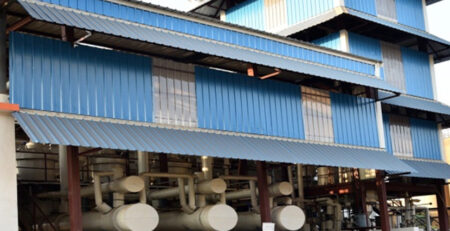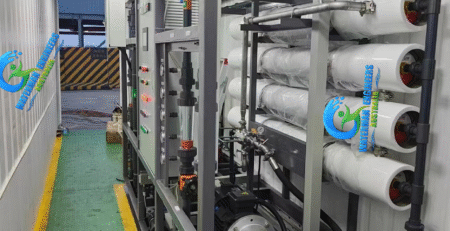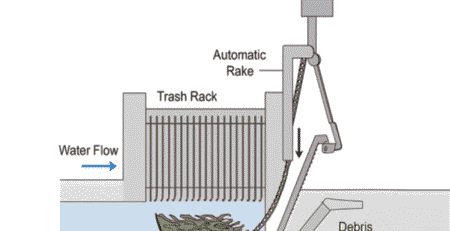Agitated Thin Film Evaporator-Use of ATFE in Wastewater Treatment, Zero Liquid Discharge System
Overview
Agitated thin film evaporators are often employed for fluids with high viscosity and sensitivity that is complex to tackle. Impediments with complicated materials are successfully handled by agitated thin-film evaporation. The process uses mechanical agitation of the moving substance film under regulated conditions and indirect heat transfer to swiftly segregate the volatile from the less volatile components. The separation is usually done under a vacuum to maximize the difference in temperature while retaining the most suitable product temperature and to enhance volatile stripping and recovery.
An evaporator like this has two main parts: a rotor that spins at a high speed inside the shell and a jacketed shell. At the upper edge of the framework, the feed is introduced. The distributor distributes along with the shells that are tangential to it. The rotor blades stir the feed and disseminate it uniformly across the hot surface creating a thin coating. The heat source going through the jacket evaporates the volatile ingredient in the feed. Prior to exiting through the vapor nozzle, the flow counter is emptied inside an entrainment separator. The concentrate product is dispensed at the bottom.
Agitated thin film evaporators Working Principle:
ATFE refers to the evaporation of a liquid to produce flakes or dry powder from a concentrated liquid. The ATFE is the optimum machine for converting condensed material into solid samples in a constant cycle. ATFE is made up of a vertical and cylindrical body with a thermal jacket and a rotor within the shell containing rows of pendulum blades all way down the dryer’s length. The liquid feed product was distributed in a thin film across the heated wall by the hinged blades. The heat then transfers from the jacket towards the principal shell underneath the streamlined agitation. The turbulence enhances as the object goes through the release prior to accessing the calming zone located behind the blades. The liquid will evaporate as well as the liquid would then transform to cake, slurry, flex, or dry powder. The vapours generated ascend upwards, counter-current to the liquid, and travel through the ATFE’s vapor outlet’s Cyclone separator. These vapours will then be condensed and collected as residue in a condenser. For temperature-sensitive items, the equipment will be maintained under vacuum, and for standard drying, it would be operated under atmospheric conditions.
Features of Agitated thin film evaporators
- It only stays for a few seconds before moving on. As a result, it’s great for heat-sensitive items.
- It allows evaporation in a single pass without diversion or deterioration.
- It has the strong agitation of the film which prevents scaling on the heat transfer surface It’s been proven that turning down the volume is a good idea.
- It has a short product lifespan.
- Depending on the application, different rotors might be used.
- It has a vertical arrangement with sizes ranging from 0.15 to 40 m2. On request, it can be made larger.
- It is suitable for vacuums ranging between 1-2 mbar abs to atmospheric pressure, as well as positive pressure.
- There is a rigid L-type lobed rotor; which has definite and well
- clearances from the heater surface.
- The rotor traverses the heated plate with some mm gap which causes a lot of liquid turbulence.
- There are many different types of viscosity.
- It has reasonable concentration ratios.
- It’s designed for high viscosity operations with the toothed lobed rotor.
- The bottom pillow is a sleeve bearing that works into the processing atmosphere and has many lubrication choices. But it can also supply needle bearings with process-side sealing.
- Materials having viscosities of 1 to 50,000 cP can usually be processed by a typical thin-film evaporator.
- In the region of 50,000 to 20 million cP, special transporting rotor layouts can be used.
- For highly reactive products, relatively low inventory and operation in the process zone at near-equilibrium conditions are critical.
Applications of Agitated thin film evaporators
The following are some of the applications for ATFE systems:
- Pharmaceutical Industries
- Textile Industries
- Agro Chemicals Industries
- Sugar Industries
- Paints and Dying Industries
- Effluent Treatment Plants
- Product Drying
- Chemical Organic Industries
- Salt recovery from concentrated liquid drying
- Chemical product drying for powder recovery
- Petrochemical product drying for powder recovery
- Refining Oils Industries
Advantages of Agitated thin film evaporators
An agitated thin-film evaporator has the following benefits:
- The heated zone has a short residence time, estimated at seconds to minutes.
- Because of the rotor’s turbulence, the thermal efficiency is quite high.
- The connector flows with minimal level back-mixing.
- It has the ability to work with viscous products and high solids concentrations.
- The product disintegration is reduced, resulting in increased yields.
- The rotor’s squeezing of residues results in high recovery.
- Agitated thin-film evaporators offer a lot of operational versatility.
- A single system can be set up to handle a wide range of products in a number of situations.
- An agitated thin film evaporator is often operated at decreased pressures in the 2 to 250 mmHg abs range.
Limitations
The disadvantages of agitated thin film evaporators are the following:
- It costs more than standard evaporation equipment.
- Staging or vapor recompression for power generation and recovery is not a viable option.
Technologies
There are three types of technologies associated with agitated thin film evaporator
- Evaporation Technology
- Dryer Technology
- Short Part Distillation Unit
1. Evaporation Technology
The primary components of a thin-film evaporator are a cylindrical heated body and a rotor. A wiped film evaporator is another name for a thin-film evaporator. The rotor spreads the substance accurately over the evaporator’s inner side of the surface. Once it’s been delivered, it’ll be placed above the heating chamber. The rapid rotor tip velocity causes fluid movement. Using capacitive heat transfer, gaseous products are rapidly vaporized. Depending on the requirements, gases flow both neutralize or simultaneously through the unit. After departing the gaseous compound discharge, vapours are ready for condensation or further treatment (i.e. fractionation) in both scenarios. There is an outlet from where non-volatile chemicals are evacuated. The rotors blades’ constant agitation and blending minimize clogging of the radiator wall, where the product or residue is in concentrated form.
TDS in the distillate stream of evaporators is typically less than 10 ppm (Total Dissolved Solids). The FFE (also known as a brine concentrator) is the most commonly utilized, as it can lead to feeding concentrations of up to 300,000 ppm, causing a boiling point increase (BPR) in the brine and necessitating either a huge heat-transfer area (high CAPEX) or a high heat temperature (large OPEX).
TFEs are frequently used to reduce the water content to less than 5%. Because of the low liquid hold-up, this technology is easy to operate and start up and shut down quickly, just like the FFEs. TFEs are employed in high-viscosity fluids and high-scaling products. It can handle modest to medium flow rates.
To manage heat-sensitive, viscous, and fouling operations, the Thin Film Evaporator combines the following characteristics
- Intense Turbulence
- Exceptionally Limited Residence Time
- Efficient Thermal Transfer
- Fast surface renewal
Construction of Thin Film Evaporator
- Product Bow wave
- Counter-Current Vapor Outlet
- Co-Current Vapor Outlet
- Concentrate Outlet
- Product Bow wave
Working Principle
For the separation of a mixture on the basis of heat, a narrow layer is produced on the heated surface of a cylindrical or conical evaporator. A distributing band on the rotor distributes the liquid evenly around the circumference. The water is then spread by the fixed blades to the rotors as a thin layer of at least 0.5 mm across the heat transfer surface. A bow wave is created before each rotor blade, according to the model concept for the flow in the thin-film evaporator. Fluid is supplied from the bow wave of a very turbulent area with intense heat and mass movement in the gap between the rotor blade and the heating surface.
 Selection Criteria
Selection Criteria
Case-by-case, the right evaporator is chosen based on a number of parameters, including:
- Viscosity of the Feed Solution
- The product’s nature and the solvent’s composition
- Characteristics of fouling
- Foaming characteristics
Types of Thin Film Evaporator
Vertical and horizontal thin-film evaporators with cylindrical and conical heating jackets are available. At the top of the apparatus, the product to be processed is fed. The volatile substances dissipate. They were removed from the evaporator at either the upper or lower end. Before the vapor is delivered to the next phase in the process, any entrained droplets of foam are removed. Vertically thin-film evaporators with spring scraper elements and DVS with Smith-Rotor are different for various applications such as the isolation of monomers from pre-polymers and polymers. The wiper components, which are made of PTFE or graphite, support the liquid in the film.
Advantages Thin Film Evaporator
- Treatment of thick, polluting, and contaminated solutions in a dependable, constant fashion
- Because of the short resident duration and limited stay time dispersion, the treatment is moderate.
Short Path Distillation Unit
A Molecular Distillation Unit (MDU) is another name for a Short Path Distillation Unit (SPDU). It differs from a standard Agitated Thin Film Evaporator because it has an inbuilt condenser. There is no pressure loss because the vapor generated on the heated surface travels only a short distance to reach the condenser surface. Operating in a fine vacuum of 0.001bar is possible.
Advantages of Thin Film Evaporator
- It has a lower boiling point of about 100 to 150° C due to enhanced vacuum
- It has a brief residence duration of a few seconds.
- It has outstanding turndown capability
- It has a heating temperature of around 400 degrees Celsius.
- In a single pass required distillation is achieved
- Ideal for handling heat-sensitive and high-boiling items softly
Major Concerns in ATFE:
Evaporation can cause technical issues, especially when the technique is used in the food business. Some evaporators are sensitive to variations in the viscosity and consistency of dilute solutions. Due to a lack of circulation, these evaporators may work inefficiently. The pump may need to be replaced if the evaporator is used to concentrate a viscous solution.
Fouling can also develop when hard deposits accumulate on the surfaces of the evaporator’s heating media. Proteins and polysaccharides in foods can form deposits that impair heat transfer efficiency. Foaming can also be a problem because dealing with surplus foam can be time-consuming and inefficient. Antifoam agents must be employed, although only a handful can be utilized during the processing of food.
When acidic liquids, such as citrus juices, are concentrated, corrosion can develop. Evaporators’ long-term life may be shortened as a result of surface degradation. Food quality and flavour can be harmed by evaporation. Overall, the properties of the product solution must be carefully considered while selecting an evaporator.
Marine Application:
Evaporating plants for wastewater recovery are commonly carried by large ships to create freshwater, minimizing their dependency on shore-based supplies. To maintain boiler-water levels, steamships must be able to produce high-quality distillate. Ships with diesel engines frequently use waste heat as a source of energy for creating freshwater.
In this setup, the engine cooling water is transported through a heat exchanger and chilled by concentrated seawater (brine). Because the cooling water (chemically treated freshwater) is at a temperature of 70–80-degree Celsius (158–176 °F), flashing off any water vapor would require lowering the pressure in the heat exchanger vessel.
Agitated Thin Film Evaporator Frequently Asked Questions
1) How does a thin film evaporator work?
Based on their volatility, the components of a process liquid are separated using evaporators. The fundamental procedure entails heating a liquid, which causes it to evaporate and leaves the less flammable substance behind.
2) What is the principle behind rising film evaporators?
Rising Film of Chemical Process Evaporators work on the “Thermo-Siphon” theory. Feed product enters the heating tubes at the bottom, where it heats up and produces steam. As a result of the steam’s upward push during the boiling process, liquid and vapour are forced upward in parallel flow.
3) What is the main advantage of agitated film evaporator?
An agitated thin-film evaporator has the following benefits: a brief period of time-a few seconds to a few minutes-in the hot zone. High heat transfer coefficients as a result of the rotor’s turbulence. Plug flow with the least amount of back-mixing.
4) When can we use agitated thin film evaporators how it works?
Because of their higher sensitivity and viscosity, agitated thin film evaporators are generally utilized with fluids that are challenging to handle. Two essential parts make up such an evaporator: a jacketed shell and a rotor that rotates rapidly inside the shell. The feed is placed inside the top mechanism.
5) What are 2 types of evaporators?
Evaporators can be categorized as falling film evaporators, nucleate boiling evaporators, flash evaporators, and direct contact evaporators. In falling film evaporators, evaporation occurs from the film interface with no nucleate boiling at the wall.











